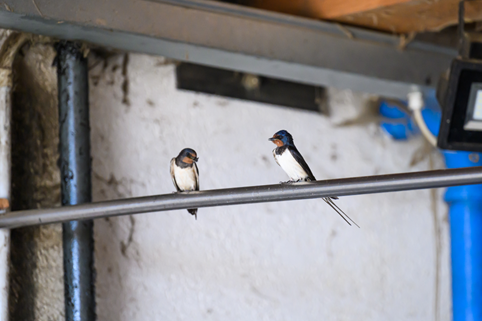Authors of a research article recently published in Journal of Applied Ecology talk us through how barn swallows are effective biological control agents for lowering pest fly activity in livestock farms.
Preamble: Farmland birds, filth flies and the landscape of fear
Birds are key suppliers of crucial ecosystem services worldwide, and insectivorous species can consume up to 400 – 500 million tons of prey each year. For this reason, farmland insectivorous birds are key controllers of agricultural insect pests, but such benefits are often overlooked and largely unknown to farmers. This is why the Science Museum of Trento (Muse), Lipu and the University of Milan developed the project “Ecosistema Rondine” (Ecosystem Swallow), to study the role of barn swallow Hirundo rustica as pest controller and to raise awareness and implement new conservation strategies.
We started with one of the biggest problems in the zootechnical field: filth flies, well known as pathogens’ vectors, that affect animal health and cause economic damage in cattle industries. Just to give an idea, the Stomoxys calcitrans alone causes losses of around 2.2 billion $ per year in the US only.

Because we value Nature Based Solution (and, admittedly, we enjoy thinking outside the box), we approached the pest control problem from a perspective that is usually associated to interspecific dynamics between much larger species, such as large carnivorous and herbivorous mammals: the landscape of fear.
In a nutshell, the landscape of fear is the spatial perception of predation risk that triggers predation avoidance behaviours in prey. Anti-predator behaviours of insects may include increased alertness and decreased feeding activities (keep that in mind, it will be useful later). Hear this out: what if swallows inside the shed could trigger a ’landscape of fear’ dynamic determined by predation on flies, decreasing the activity rate of flies and therefore annoyance for cows?
The project: Ecosistema Rondine
The barn swallow, an iconic farmland insectivore and a long-distance migrant of high cultural relevance, underwent a dramatic decline throughout Europe. Agricultural intensification, insecticides and climate change add to other impacts on both wintering and breeding grounds of this migratory species. In this context, livestock farms seem to be preferred by swallows, whose reproductive output benefits from higher temperatures and abundant flies.

However, the potential role of aerial insectivores – such as the barn swallow – in decreasing the density and activity of flies within livestock farm is currently understudied. This is a perfect example of a potentially very relevant ecosystem service supplied by birds, which remains largely neglected by relevant stakeholders. Therefore, if barn swallows may reduce fly activity in cattle sheds, this would be highly beneficial for farmers, and would also provide striking evidence for a relevant ecosystem service supplied by swallows.
To assess whether the presence and abundance of swallows inside the cattle shed influence the activity rate of pest flies, we assessed the relative abundance of swallows and flies from April to August 2022 in cattle farms in Non valley (Trentino, North-east Italy), either occupied or not by nesting swallows. We collected weekly data on the activity rate of flies by placing eight white spot cards inside each of the nine cattle sheds and counting the deposition of faecal and regurgitation spots by flies. Simultaneously, we also recorded the number of swallows inside the sheds. It’s a dirty job, but somebody had to do it!
By counting the faecal and regurgitating spots, we found that the activity rate of flies followed a seasonal trend with a peak in July, that was however markedly lower where swallows were present. Moreover, the positive relationship between flies and temperature was lessened when swallows were abundant.

What now? One swallow doesn’t make summer
After thousands of years this species can still play a role in human culture: barn swallows evolved alongside humans’ settlements and nowadays sheds provide crucial breeding sites. Our work demonstrated that swallows can be effective biological control agents for lowering the activity of pest flies in livestock sheds, which in turn can reduce financial losses, and enhance animal welfare. Such result is a win-win outcome for biodiversity conservation and farm activities.
Harnessing the ecosystem services supplied by farmland birds could bring positive outcomes for people and biodiversity. To do so, there must be a concrete effort in the implementation of actions to promote swallow occurrence and their coexistence with livestock husbandry.
In this project farmers were actively involved in the conservation of swallows and of their breeding sites within their sheds, also by signing a memorandum of intent. With a final plot twist, cattle sheds can play a pivotal role in the long-term conservation of this migratory passerine and farmers can be great allies of farmland birds!
Read the full article “The landscape of fear in cattle farms? How the presence of barn swallow influences the activity of pest flies” in Journal of Applied Ecology.


